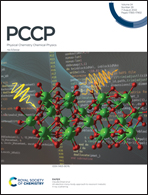Theoretical investigation on the reaction mechanism of UTP cyclohydrolase†
Abstract
Nucleoside triphosphate cyclohydrolase (UrcA) is a critical enzyme of the uracil catabolism pathway that catalyses the two-step hydrolysis of uridine triphosphate (UTP). Although the recently resolved X-ray structure of UrcA in complex with substrate analogue dUTP provided insights into the structural characteristics of the enzyme, the detailed catalytic mechanism, including how the reaction intermediate accomplishes conformational conversion in the active centre, remains unclear. In this study, extensive DFT calculations and MD simulations were performed to investigate the catalytic reaction process of UrcA. This study shows that the first hydrolytic reactions in UrcA follow a three-step mechanism, while the second hydrolytic reaction follows a two-step mechanism. Glu392 plays a critical role in deprotonating the lytic water in both hydrolytic reactions. The rate-limiting step of the first hydrolytic reaction lies in the cleavage of the uracil ring, in which an extraneous water molecule bridges the proton transfer from C6–OH to N1 to enable the reaction to go through a six-membered transition state with relatively low steric tension. In the second hydrolytic reaction, Glu392 abstracts protons from the lytic water and directly transfers them to the nitrogen atom of the cleaved C4–N3 bond so that the hydrolytic reaction is no longer rate-limited by the C–N bond cleavage step. MD simulations show that the reaction intermediate experiences spontaneous conformation overturn in the active site of UrcA under the assistance of the hydrogen bond interaction from Tyr307 to place its C4–N3 bond alongside the Zn2+ centre of the enzyme to trigger the second hydrolytic reaction.



 Please wait while we load your content...
Please wait while we load your content...